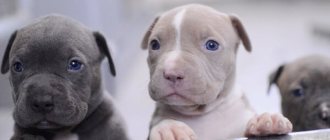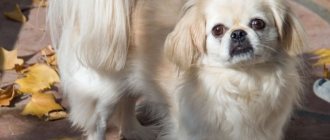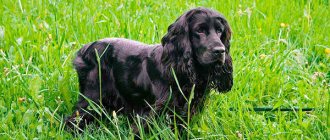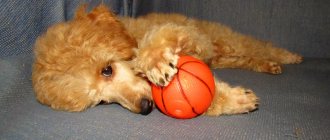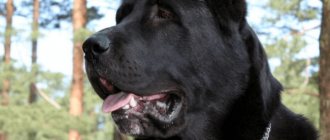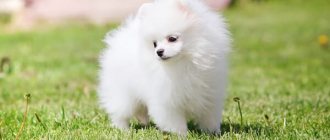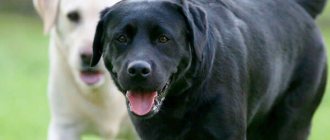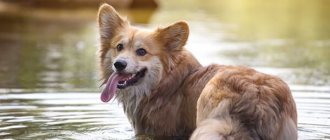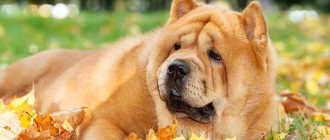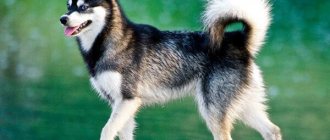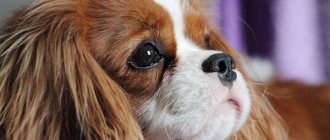Alabai is the oldest dog breed that has managed to preserve its distinctive characteristics and character traits.
These are proud, freedom-loving animals with excellent watchdog and security qualities.
But no matter how independent and independent these dogs are, as puppies they need care and attention no less than others.
We will talk about how to care for Alabai puppies in this article.
Photos and descriptions of newborn puppies
Newborn Central Asian Shepherd Dog (CAO) puppies have a round, dense body; they are born with short legs, a small tail and a large rounded head. Babies are born weighing 350-550 g, their eyes and ear canals are closed.
Of all the senses, only the sense of smell is developed, with the help of which they distinguish the smell of the mother from strangers and instinctively cling to her in search of not only food, but also warmth, since they do not yet have thermoregulation.
The eyes open approximately 10-14 days after birth, and the ear canals open a few days later. But puppies begin to see and hear well only at 3 weeks of life.
Alabai health
Representatives of the breed do not suffer from hereditary diseases and have excellent health. Such characteristics prove that with proper care, a purebred dog can live up to fifteen years of age. If the animal is not purebred, it dies at the age of ten. The peculiarity of the Alabai is that for the first 3 months of its life it is protected by its mother’s immune system, and then it can become ill with viral diseases.
Photo from Instagram account ermolenkoyulia
The pet is vaccinated according to the schedule, adding several additional ones to the mandatory vaccinations (against piroplasmosis, parainfluenza, infectious tracheobronchitis). Large dogs suffer from problems with the musculoskeletal system, congenital dysplasia of the pelvic joints or elbows.
If large dogs live in an apartment or confined space, they suffer from lack of physical activity and obesity, myositis and arthrosis. Rapid weight gain should not be allowed, as the load on the heart and joints increases, even leading to heart attacks and cardiac arrhythmias.
Development 1 to 12 months
The table below shows how the size of the Alabai changes as it grows, as well as how the puppy develops.
| Age | Height at withers, cm | Weight, kg | Description |
| 1 month | 25-30 | 3-5 | If puppies are healthy and well-nourished, they will gain significant weight and height within 1 month of life. It is still impossible to distinguish males from females |
| 2 months | 30-35 | 9-10 | The beginning of a period of intensive growth of bones and muscles, the dog becomes taller and heavier, which is due to the deposition of calcium salts in the skeleton |
| 3 months | 40-45 | 15-20 | The musculoskeletal system continues to develop. It is necessary to exclude high physical activity and active training, since the dog’s bones are still too fragile |
| 4 months | 50-55 | 25-30 | At this age, the puppy’s limbs and body lengthen noticeably, as the skeleton grows rapidly, dense bone tissue is formed and the skeleton is strengthened, the body becomes elongated |
| 5 months | 55-58 | 35-37 | The growth of the skeleton and the formation of the chest continues, the intensity of growth in most representatives of the breed decreases |
| Six months | 65-70 | 40-50 | After 6 months, active muscle formation and breadth growth are observed. At 6-8 months, skeletal growth increases, the bones are finally formed and strengthened |
| Year | 80 | 70-80 | Around 9-10 months, bone growth and breast formation finish; weight gain is due to muscle building |
Alabai height and weight chart
The main question for the owners of Central Asian Shepherd puppies is how much the pet weighs at birth and by month, and how tall at the withers a growing dog should be. The growth dynamics of Alabais is a very average concept, since Central Asian Shepherds grow very unevenly.
Sometimes, a cute baby, who has the smallest height and weight at birth, overtakes his brothers and sisters within 2-3 months, turning into a massive handsome man. Or, exactly the opposite, the largest well-fed puppies quickly grow in height only up to 6-7 months, and by 12 months, compared to their peers, they look short with undeveloped muscles.
The height and weight of a large animal largely depend on feeding, care and training, heredity and individual characteristics of a particular dog, therefore there are no strict standards for Alabai puppies depending on the age of the pet. Girls and boys develop and gain weight at different rates. Adult males look more massive and intimidating than females of the same age.
Male and female Central Asian Shepherd
Veterinary specialists and dog handlers have developed a table of height and weight of Central Asian Shepherd puppies depending on age, thanks to which the owner of a growing pet can monitor the compliance of the dog’s parameters by month.
It is worth saying that the table shows the average weight and height of the Alabai, since puppies of even the same litter grow very unevenly.
Table of height and weight of Alabai puppy by month
| Puppy age, month | Height at the withers of a male, cm | Height at the withers of the female, cm | Male weight, kg | Bitch weight, kg |
| 1 | 25 | 24 | 5 | 4 |
| 3 | 47 | 45 | 18 | 16 |
| 6 | 65 | 61 | 38 | 34 |
| 12 | 75 | 70 | 40-80 | 35-65 |
The height of an adult Alabai can sometimes be 78-85 cm; there are males up to 96-98 cm at the withers. But with high height or weight, serious health pathologies and deviations in exterior characteristics are observed, which negatively affects ratings in international and Russian exhibitions, recommendations for use in breeding. It is much more important that, with average values, the pet is proportionally built and has girths of the head, muzzle and pastern corresponding to its age, which are used to judge the correct formation of the body and compliance with generally accepted standards.
The weight of an Alabai puppy varies very unevenly over the months depending on the age and individual characteristics of the dog. From 1 month to six months there is a very intensive weight gain, and the weight of the young pet increases almost 7 times, mainly due to the growing bones. Up to a year, the weight increases by only 2 times; during this period, the growth of the skeleton is completed and the formation of muscles occurs. The question – how much should a Central Asian Shepherd puppy weigh at a certain age is also incorrect, since the development of the musculoskeletal system in pets occurs in completely different ways.
To what age do alabai grow?
The active growth of Alabai in height continues up to 8 months, then it becomes insignificant and finally stops at about 10 months. At the age of 1 year, a Central Asian Shepherd puppy looks like an adult dog; it has a narrow torso, but not yet very developed muscles.
After bone growth stops, the correct exterior characteristics inherent to this breed are formed, which is due to the build-up of muscle mass.
Males are formed up to 2.5-3 years, in some individuals this period lasts up to 5 years. The maximum development of bitches occurs before 1 heat, i.e. 9-18 months.
NOTE!
During the formation of muscles at 2.5-3 years, the dog’s height, due to an increase in mass and relaxation of ligaments, decreases by 2-3 cm.
Exterior breed standards
The official standards for Central Asian Shepherd Dogs according to FCI No. 335 are as follows:
- Large square head, proportional to the body, without folds at the top and with a smooth transition from the neck to the shoulders.
- Short, blunt, rectangular muzzle.
- Large black nose. In fawn-colored Central Asian Shepherds, light colored lobes are acceptable.
- Wide massive jaws with pigmented lips.
- Massive muscular cylindrical neck.
- Large dewlap to protect the neck from bites or injuries.
- Wide and powerful chest.
- The limbs are straight, parallel to each other and set wide apart.
- The body is slightly elongated with a wide back, deep chest, slightly tucked belly and short loin. The withers of males stand out more than those of females.
- The tail is widened at the base, sickle-shaped or with a slightly curled tip.
- The coat color can be different: white, fawn, red, brindle, gray or black, both solid color and spots are acceptable. Blue or brown colors are considered disqualifying.
The ears and tail of the Alabai can be docked in countries where this procedure is legal.
Basic care rules
The newborn puppies are cared for by the bitch, who warms them, feeds them, and licks them to stimulate defecation and urination. As puppies grow older, most of the care for them falls on the breeder, and later on the owner.
It is important to feed small Alabais correctly, ensure that their body receives a sufficient amount of vitamins and microelements, promptly vaccinate and carry out deworming and treatment for external parasites.
Also, caring for a puppy includes a set of hygiene procedures, including bathing, combing, cleaning eyes, ears, and trimming nails, which must be taught to the puppy from an early age.
Grooming
Until the end of quarantine after the last vaccination, bathing the dog is prohibited. In the future, representatives of this breed also do not require frequent washing - it is enough to do this once a quarter when kept at home and once a month when kept outdoors, using shampoo that matches the type of coat.
IMPORTANT!
When bathing, you need to make sure that water does not get into your pet's ears.
The coat needs to be combed 1-2 times a week, during shedding - every 2 days.
Cleaning teeth, ears, trimming nails
Even though the ears of Central Asian Shepherds are well ventilated, the ears need to be monitored and cleaned every 7-10 days. To do this, you need to use cotton pads soaked in a special lotion or hydrogen peroxide.
If there are plans to crop the Alabai’s ears, then it is better to carry out this procedure in the first months of the puppy’s life.
To prevent the formation of plaque, you need to brush your pet’s teeth with a special brush and let him chew on toys and treats. If this does not help, you should contact your veterinarian, who will remove plaque and stones manually or using ultrasound.
For the first time, the puppy’s claws need to be shortened at the age of 3 weeks, then they need to be trimmed as they grow back with a guillotine nail clipper so as not to touch the living part.
Price
The cost varies depending on the type of dog and its color. If the alabai is white, then the price for it is much higher than for spotted individuals. The region in which the dog is sold plays a big role: if it is the center, then the price is the highest there. However, the build of an Alabai puppy does not affect its cost in any way, and its large size does not mean that the dog is expensive.
A puppy with a breeding match can be purchased for 10 thousand rubles - such a dog is perfect for a summer residence and guarding a home, but not for exhibitions. Alabai with a simple appearance without distinctive features cost around 15 thousand rubles. For 20-45 thousand you can buy a very high-quality and beautiful Alabai, which can also be taken to exhibitions and competitions.
How to choose?
To buy a good healthy Alabai puppy, follow these tips:
- Buy a dog not from an online store (such as Avito) or from a poultry market, but from a nursery. This way you can examine the puppy with your own eyes, assess its health and make sure it is purebred.
- Pay attention to the puppy's parents - they should look healthy and mentally stable.
- The puppy should be picked up at the age of 2 months. Before doing this, be sure to make sure that the breeder has given him his first vaccinations.
- Do not choose cowardly ones, especially if you are choosing a guard dog. You can drop the keys and see which puppies will get scared and run away, and which ones will run closer to examine the fallen object.
- Pay attention to the length of the puppies' coat - in a real Alabai it should not be too long, the dog's appearance should resemble a teddy bear.
- Assess the condition of the animal by its external signs: a wet nose, clean eyes and straight paws - all this indicates a healthy puppy. It is also advisable that the dog's tail and ears be cropped.
Girl
Girls are smaller in size, they are calmer and more pliable. They are characterized by curiosity and mobility, but they are less strong than boys. They also get along well with children due to their gentle nature.
Boy
More powerful than girls due to their confidence in strength, large size and desire for leadership. Due to these qualities, it is necessary to correctly and promptly win over the male dog so that in the future there will be no difficulties with his behavior.
With documents
If your goal is to purchase a purebred Alabai, then the presence of documents at the time of purchase is a significant guarantee of the quality of the individual. Moreover, the presence of documents indicates that the animal is free of inherited diseases.
The set of documents includes:
- a card containing information about the name of the dog, his mother and father;
- stamp number;
- Date of Birth;
- name of the breeder or organization that issued the documents.
Also included is a veterinary passport, which records all vaccinations given and the pet’s health status.
How to toilet train?
To train an Alabai to use the toilet, you need to allocate a place in the house for this, fence it off so that the puppy cannot get out, put bowls of food and water, several toys and a place to sleep there. Cover all available space with newspapers or absorbent diapers.
The puppy should be placed in such an improvised enclosure while the owner is away, after sleeping and feeding. This will help the little Alabai learn to go to the toilet only on newspapers or diapers. Every time the dog relieves itself in the designated area, it must be praised and treated with a treat.
Gradually, the number of diapers needs to be reduced, and a tray should be placed in the free space. After the Alabai gets used to going to the tray, the fence can be removed.
If the puppy wanders past the litter box, you need to scold him, but you cannot hit him or poke him with his nose.
What does an Alabai puppy look like?
The litter size of the breed is small - 1-2 large puppies. Newborns already look charming and weigh only 300-600 g, while they are deaf and blind, and have soft fur on their bodies. The fluffy Alabais still have a lot of time to become the real protectors that everyone is used to seeing them. They look like furry bear cubs.
The color of the Alabai may change during puppyhood:
black – scorched; orange will acquire a brighter reddish-golden hue or may, on the contrary, become more fawn; Pure white will remain that way with proper care.
What to feed for the first 3 months?
The best option for feeding puppies is breastfeeding for up to 2 months and adding complementary foods starting from 2 weeks of age. As complementary foods, 50 g of calcined cottage cheese and 100 ml of goat milk should be given; after 3 weeks, raw scraped meat, previously scalded with boiling water, can be introduced into the diet.
At the age of 1 month, a Central Asian Shepherd puppy should eat 150 g of raw minced meat, 100 g of calcined cottage cheese, 100 g of cereals, 200 ml of milk and fermented milk products, 100 g of vegetables, 1 tsp. vegetable oil, nuts.
At 2 months, the puppy's menu does not change, but it is necessary to reduce the number of feedings, increase the size of portions, and continue to gradually introduce new foods into the diet.
At 3 months, puppies need to be given boiled low-fat sea fish, offal, vegetables, fruits and herbs 2-3 times a week. A puppy at this age should eat 300 g of raw meat or fish or 450 g of offal, 150 g of porridge, 450 ml of dairy products, 150 g of vegetables per day.
NOTE!
It is better not to feed puppies under 3 months of age with industrial food; if necessary, you should buy Starter food.
Character formation and periods of social adaptation
Alabai babies up to two weeks of age need close physical contact with their mother and fellow tribesmen. On the 11th, 12th day of life, the puppies' eyes open, but full vision and hearing appear in the 3rd week, at the same time the sense of smell improves. Crawling puppies stand on their paws and begin to move. The urgent need for contact with the mother is lost.
Imprinting stage
At 4-7 weeks, puppies become more active and the need for games appears. It is at this age that the first quarrels in the brood arise. Socialization of Central Asian Shepherd puppies begins at the imprinting stage; they actively become acquainted with the environment, new objects, and strangers. During this period, an important aspect is interaction with a person, in order to eliminate later problems of communication with the owner. The more attention the puppies receive from the breeder at this age, the more open and friendly the character will be in the adult dog. The positive emotions of puppies received from the breeder program the dog’s memory.
Socialization stage
The best time to move to a family is 8-10 weeks of the baby’s life. Puppies at this age are predisposed to new communication and getting closer to people. At this stage of development, it is important to draw boundaries for correct behavior with your pet. It is at this age that one should show firmness and persistently show the pet that he is obliged to obey and carry out the orders of the owner. This should be done gently and consistently, and generously praised after completion. When raising an Alabai, it is important to maintain consistency in your own behavior; you cannot scold and praise for the same action; with such behavior, the dog will double-check the owner’s orders and will not carry them out in full. At this age, it is necessary to introduce the pet to other dogs, accustom it to wiring, and adapt it to urban conditions.
The beginning of youth
The age of 13-18 weeks marks the beginning of adolescence; the puppy’s character has not yet fully developed and can be adjusted. By the end of this time, the relationship between the human leader and the dog should be completely established.
Youth
5 - 6 months is a certain milestone for the Alabai in the formation of pack relationships. A grown-up puppy, with proper upbringing, already follows commands. At this time, the teeth are changing, the owner should treat the pet with increased patience, since the desire to gnaw on everything that attracts attention will be stronger than his good manners.
Growing up
This stage lasts up to 2 years. At the age of 8 - 9 months, Central Asian Shepherd puppies show initial signs of the guarding instinct and demonstrate protective behavior. The defense of one's territory becomes pronounced. Praise and approval from the leader of the pack will only strengthen the efforts of the shepherd dog. Over time, these skills only become stronger. During the period of growing up, it is important to maintain your own authority in the eyes of the dog; when punishing an Alabai, remember that rough measures are prohibited. By two years of age, the dog's character and behavior will become more consistent and fully conscious.
No matter how much the owner wants to extend the childhood of his “teddy bear,” time flies quickly. And already at 6 months the baby will look like a calf. Having a trusting relationship with your dog, by the age of two you will have the most devoted and faithful friend, a reliable guard and defender of the territory.
How to feed a grown pet correctly?
Feeding is the basis for the proper development of a dog, especially during the period of active growth and skeletal formation.
It is necessary to create a diet so that it is based (30-50%) on protein products - meat, fish, offal, milk and fermented milk products. Little Alabai also require carbohydrates and fiber, which they can get from cereals, vegetables and fruits.
The number of feedings per day depends on the age of the dog:
- up to 1 month – 9;
- 1 month – 6;
- 2-3 months – 5;
- 4-6 months – 4;
- 6-10 months – 3;
- after 10 months and older – 2.
IMPORTANT!
Errors in nutrition made during development can cause the development of pathologies.
Weekly diet for a puppy at 4-5 months
| Day of the week | Menu |
| Monday | 500 g beef, 200-250 g rice porridge, 20 g vegetable or butter, 700 g calcined cottage cheese, 200 g stewed carrots and zucchini, 1 egg, 200 g rye bread, bran and herbs |
| Tuesday | 500 g veal, 200-250 g buckwheat porridge, 20 g vegetable or butter, 400 g calcined cottage cheese, 300 ml kefir, 200 g boiled pumpkin, 200 g rye bread and herbs |
| Wednesday | 500 g beef, 250 g rice porridge, 20 g vegetable or butter, 300 g calcined cottage cheese, 150 ml kefir, 150 ml yogurt, 200 g pumpkin and zucchini, 200 g bran and herbs |
| Thursday | 500 g veal, 200 g rice porridge, 20 g vegetable or butter, 400 g calcined cottage cheese, 300 ml kefir, 200 g carrots, tomatoes and apples, 200 g rye bread and herbs |
| Friday | 500 g fish, 250 g buckwheat porridge, 20 g vegetable or butter, 700 g calcined cottage cheese, 200 g cucumbers and tomatoes, 200 g rye bread, bran and herbs |
| Saturday | 600 g offal, 200-250 g rice porridge, 20 g vegetable or butter, 500 g calcined cottage cheese, 200 ml kefir, 200 g bell pepper and carrots, 1 egg, 200 g bran and herbs |
| Sunday | 500 g fish, 200-250 g buckwheat porridge, 20 g vegetable or butter, 400 g calcined cottage cheese, 300 ml yogurt, 200 g beets and tomatoes, 200 g rye bread, bran and herbs |
Caring for the Central Asian Shepherd in the first month
What happened during this time:
1-2 weeks: puppies opened their eyes
Week 2: docking of the ears and tail of a Central Asian Shepherd (up to 1 month), all breeders are divided into those who believe that Central Asians should be docked, and those who consider this inhumane and leave the puppy with ears and a tail. If cupping is planned, it is important to do it in the second week, because later it will be more difficult and dangerous. (Under general anesthesia)
Let's compare what a puppy looks like at 1 month with ears and tail and after docking:
Week 3: deworming (getting rid of worms), preparing for upcoming vaccinations.
On a note! Puppies fed by a vaccinated bitch receive protection from diseases through their mother's milk, so vaccinations are not given until they are 1 month old. However, this does not provide a 100% guarantee that the puppy will not become infected, so it should be limited as much as possible from contact with other people’s pets. If puppies do not feed on milk, they will have to be vaccinated much earlier.
At 1 month, small CAOs begin to walk, it is important that at this age, it is too early to buy puppies, they are just starting to walk and are still clumsy, their paws are clubbed
they move mainly by hopping and acquiring a puppy at the age of one month
you won't notice if he places his paws correctly. You can miss disturbances in the bone structure and joints, and when the puppy is two months old or more, then all the slightest defects will immediately be present in the dog’s gait.
Which dry food to choose?
Feeding representatives of this breed with cheap economy-class food (Pedigree, Chappi, Darling, ARO) is not recommended due to the content of artificial colors, flavors, flavor enhancers and other harmful additives.
In addition, the composition of such foods is based on low-quality by-products, contains grains and is not enriched with vitamins and minerals necessary for the healthy growth and development of the dog.
Premium, super-premium and holistic foods are suitable for feeding Alabais. Products from the brands ProBalance, ProPlan, Arden Grange, 1st Choice, Josera, NOW, GO!, Acana, Orijen, Hills, Eukanuba, Royal Canin, Bozita are popular.
Dog character
All shepherd dogs, regardless of color, have an already recognized “ideal character”. They are calm, reasonable, and do not show aggression without reason. They rightfully occupy first place among representatives of service dogs.
The most important thing is that the dog gets along well with the family; there is no need to fear for your children. The ideal home for her would be a country cottage, where you can show off your skills as a security guard, as well as have fun frolicking on the premises.
He is wary of strangers, but will not howl overtly with aggression. Shepherd dogs are highly valued all over the world for their loyalty, ability and balance; they are rightfully called one of the best breeds of working dogs.
Vaccination schedule
| Age | The drug and its purpose |
| 3-4 weeks (optional vaccination) | Nobivac Puppy DP – vaccine against canine distemper and parvovirus enteritis |
| 8-10 weeks | Nobivac DHPPi + Lepto – against canine distemper, infectious hepatitis, parvovirus enteritis, parainfluenza and leptospirosis |
| 10-13 weeks | Nobivac DHPPi + Lepto + Rabies – against canine distemper, infectious hepatitis, parvovirus enteritis, parainfluenza, leptospirosis, rabies |
| 6-8 months (after teeth change) | Nobivac DHPPi + Lepto + Rabies – against canine distemper, infectious hepatitis, parvovirus enteritis, parainfluenza, leptospirosis, rabies |
In the future, vaccinations must be carried out annually at the same time.
In addition to the Nobivac drug, Eurican, Primodog, and Duramune vaccines are popular.
NOTE!
Only a healthy dog can be vaccinated; deworming must be done 10-14 days before vaccination.
How to raise a healthy dog - feeding rules
For the first 10–14 days, the pet should receive the same food that the breeder fed it. This way, you reduce stress levels and avoid indigestion due to a sudden change in diet. Even if you plan to feed the dog “natural”, and the breeder prefers drying, buy food of the same brand with a supply of 15 days, starting from the 10th day, transfer the puppy to the diet of your choice using the admixture method.
Important! When feeding your puppy dry food, it is recommended to soak the granules in warm water 7-10 minutes before serving.
Natural feeding of Alabai puppies involves a diet enriched with proteins and microelements. For proper muscle formation, the baby should receive a menu of 50% meat (up to 15% offal), milk and dairy products, 10–25% cereals, 10–25% vegetables and fruits. Equally important are oils, dairy products, eggs, ocean fish (if the dog likes it) and vitamin supplements for large, fast-growing breeds. Monitor your pet's weight carefully. Obesity, especially at a young age, will lead to joint diseases, and even their physical deformation.
How to train correctly and what commands to teach?
The first “command” to which a puppy should be taught is his name.
You need to raise an Alabai puppy from the first days of its arrival in a new home.
| Team | Education |
| To me | It is necessary to call the dog by name, loudly and clearly saying “Come to me!” After the puppy approaches, he needs to be praised and treated with a treat. |
| Near | Alabai should walk next to the owner’s left leg. You need to say the command and pull the leash, preventing the dog from moving to the side or forward |
| Sit | Show the puppy a treat and after he raises his head. sit down by pressing on the sacral area |
| Ugh | A command that should frighten the pet and force it to immediately stop some action. When a puppy does something forbidden, you need to grab him by the withers, shake him lightly and clearly say “Ugh” |
How to measure height correctly
It is important to monitor the dog’s parameters in order to know how correctly the Alabai is developing; the height of both a puppy and an adult dog is measured at the withers. To accurately determine the height of an animal, you need:
- Place the dog on a flat and hard surface.
- If the puppy does not yet know the “Stay” command, you should interest him with a toy or “yummy” so that the animal does not move during the measurement (it is best to carry out the procedure with an assistant familiar to the dog, who will distract the baby).
- Measure the height of the animal from the highest point of the withers to the floor using a long ruler or measuring tape (in the latter case, it is important to ensure that the tape falls exactly perpendicular to the floor surface).
To make the measurement procedure faster and easier, you should teach your baby to correctly perform the “Stand” command.
Additional information! The Central Asian Shepherd is one of the most ancient dog breeds, which appeared more than three thousand years ago and has survived to this day in its original form.
When is weaning from the mother?
At about 2 weeks, complementary foods are already introduced into the puppy’s diet and every day he depends less and less on his mother. But he still needs her - the puppy adopts the basic norms of behavior from the bitch.
To make the puppy’s adaptation to new living conditions as easy and painless as possible, it is better to separate him from his mother at 8-12 weeks of life.
At this age, he has a positive attitude towards other animals getting closer to people, is ready to learn and has not yet had time to feel like a leader.
What weight should an adult Alabai have depending on gender?
The dog's health and activity depend on proper nutrition.
To make sure that the dog is growing normally, it is important to know how much an adult Alabai weighs.
According to the breed standard, the minimum weight for females is 40 kg, and for males - 50. The maximum weight is not limited by the rules: it can reach 65 kg for females and 80 for males. It is important to ensure that heavy dogs are not obese. Most Alabais - winners of sports competitions - weigh up to 60 kg. Larger dogs often become clumsy and less maneuverable. If the dog begins to gain weight, it is necessary to reconsider its diet and gradually increase physical activity. Additional Information! Due to the fact that the export of purebred Alabais from Turkmenistan is currently prohibited, most animals from Russian breeders are mestizos. Therefore, the weight of a dog may depend on which breeds were present in the genetics of a particular individual.
How to choose your future pet?
Before buying a puppy, you need to check with the breeder about the number of dogs in the litter - if there are more than 5 puppies, there is a high probability that they will develop serious pathologies.
It is also important to carefully examine your future pet. He must be active, inquisitive and have a good appetite.
A healthy Alabai has shiny fur without dandruff, clean skin without rashes or scratch marks, a scissor bite, a wide head, a flat forehead, and oval paws.
What does the correct development of alabai depend on?
The size of the alabai in childhood and adolescence is influenced by various factors, the main ones being:
- Proper nutrition. The harmonious development of a puppy depends on what he ate, starting from birth. To provide your baby with all the necessary vitamins and microelements, it is best to feed him special balanced and high-quality food. If the owners prepare food for the animal themselves, then it should be taken into account that two-thirds of the Alabai’s diet should consist of lean meat.
- Genetics. The rate of weight gain and growth of a puppy and the size of an adult animal largely depend on the weight and height of its parents and more distant ancestors.
- Good health. Infectious and other diseases, as well as their consequences, can lead to a slowdown in the development of the animal.
- Sufficient physical activity. Puppies that lead a sedentary lifestyle begin to gain excess weight early, while their muscular and skeletal systems develop poorly; as a result, the dog can grow up narrow-bodied.
- Good content. For the full development of the alabai, it needs to be provided with proper care and suitable living conditions.
Note! Early mating can lead to slower development of the skeletal and muscular systems in both males and females.
What are the norms for weight gain for kittens?
The first six months of a kitten's life are the most active in terms of growth. Accordingly, if the baby is healthy and develops normally, he will regularly gain weight:
Before the baby turns 1 month old, he rapidly gains weight - about 15 g per day. At the same time, by the end of the 1st week, the kitten should double its birth weight. Weigh him daily during this period. From 1 to 2 months, weight gain occurs systematically, on average 100–150 g per week. Weigh the baby once every 3 days. After 2 months, weight gain varies from person to person. It depends on the breed and nutrition of the animal. He is weighed weekly for up to 6 months, then once a month for up to a year.
It is important that there is weight gain. If it is absent, you should contact your veterinarian to find out the reasons.
Since there are no exact indicators of body weight gain (much depends on the individual characteristics of the animal, its living conditions and diet), the owner should focus on the average weight standards for kittens.
Table: average body weight of kittens in the first 6 months of life
| Age | Weight |
| 1–6 days | 70–130 g |
| 7 days | 85–200 g |
| 7–14 days | 225–400 g |
| 14–21 days | 285–500 g |
| 1 month | 500–750 g |
| 2 months | 1000–1500 g |
| 3 months | 1700–2300 g |
| 4 months | 2500–3600 g |
| 5 months | 3100–4200 g |
| 6 months | 3500–4800 g |
Short-term stabilization of weight in a kitten
The phenomenon of short-term weight stabilization often occurs. There is no need to panic if the kitten’s weight gain “frozen” for several days, and then continues in the same progression.
Such an anomaly can manifest itself at any time stage of the baby’s life. It often occurs when there is a transition from breastfeeding to regular food (dry food or natural food). This is due to the fact that the baby’s body goes through a period of adaptation to receiving new nutrients.
However, you should worry if there are no changes for more than a few days (for example, a week). This may mean that the kitten is malnourished or sick or infected with parasites. You should visit a veterinarian as soon as possible if, after weight stagnation, body weight begins to decrease rather than increase.
Table: kitten weights by month (values for popular breeds)
| Kitten age | Maine Coon cat weight (g) | Catamein Coon weight (g) | British cat weight (g) | British cat weight (g) | Scottish cat weight (g) | Scottish cat weight (g) |
| Newborn kitten | 120–140 | 120–160 | 60–140 | 70–140 | 60–140 | 70–140 |
| 1 Week | 180–230 | 200–260 | 110–250 | 240–260 | 110–250 | 240–280 |
| 2 week | 280–340 | 400–360 | 150–360 | 340–400 | 140–360 | 340–400 |
| 3 week | 420–550 | 440–600 | 210–420 | 400–630 | 200–420 | 390–630 |
| 4 week | 560–680 | 630–750 | 250–600 | 550–740 | 240–600 | 540–740 |
| 2 months | 1100–1400 | 1200–1500 | 450–900 | 1000–1700 | 400–900 | 1000–1700 |
| 3 months | 1700–2300 | 1800–2300 | 1000–1500 | 1500–2500 | 1000–1500 | 1500–2500 |
| 4 months | 2700–3600 | 3000–3800 | 1700–2400 | 2100–3900 | 1700–2400 | 2100–3900 |
| 5 months | 2900–3900 | 3000–5500 | 2200–2900 | 2600–4300 | 2200–2900 | 2600–4300 |
| 6 months | 3200–4000 | 3900–6000 | 2300–3600 | 3000–5400 | 2300–3600 | 3000–5400 |
| 7 months | 3500–4100 | 4200–6500 | 2400–3900 | 3300–5600 | 2400–3900 | 3300–5600 |
| 8 months | 3800–4300 | 4500–6900 | 2500–4100 | 3500–6000 | 2500–4100 | 3500–6000 |
| 9 months | 4100–5000 | 5000–7000 | 2500–4300 | 3800–6400 | 2500–4300 | 3800–6400 |
| 10 months | 4200–5500 | 5200–7700 | 2500–4400 | 4100–6700 | 2500–4400 | 4100–6700 |
| 11 months | 4300–6000 | 5700–8000 | 2500–4500 | 4300–6800 | 2500–4500 | 4300–6800 |
| 12 months | 4500–6300 | 5700–9000 | 2500–4600 | 4500–7000 | 3500–4600 | 4500–7000 |
How to determine weight standards for a mongrel kitten
When it is not possible to determine what breed a kitten is, it is necessary to use average indicators. The size of the baby will change in accordance with its development. There are a number of factors that allow you to predict a kitten’s weight gain. For example, when he switches from breast milk to a normal diet, the weight may decrease slightly.
After the 6th month of life, weight gain is not of decisive importance. If the cat is active, eats well, and has no problems visiting the litter box, then there is no need to worry too much. The veterinarian should be observed on a schedule determined by the doctor (basically it coincides with the vaccination schedule).
Having mongrel cats and a dog adopted from the street, I regularly visit the veterinarian. All my animals have veterinary passports, are vaccinated and sterilized. This way I protect not only them, but also my family. After all, some diseases (and at least the same worms) can be transmitted to humans. Since my children play with animals, I have a strict order in this matter.

